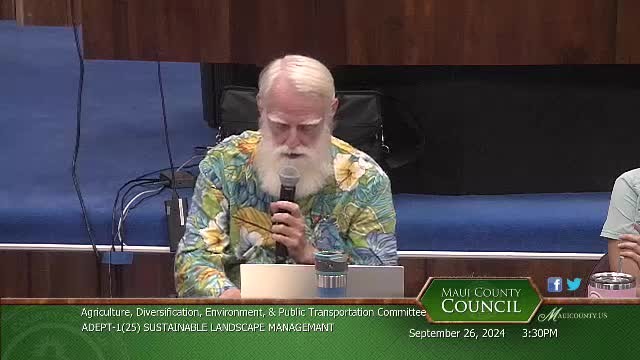Electric lawn equipment slashes emissions and costs
September 26, 2024 | Maui County, Hawaii
This article was created by AI summarizing key points discussed. AI makes mistakes, so for full details and context, please refer to the video of the full meeting. Please report any errors so we can fix them. Report an error »

During a recent government meeting, officials discussed the environmental and health impacts of traditional landscaping equipment, particularly gas-powered lawn mowers and leaf blowers. The conversation highlighted the urgent need to transition to electric alternatives, which are significantly more efficient and less polluting.
The speaker emphasized that electric mowers and other landscaping tools produce far fewer greenhouse gas emissions compared to their gas-powered counterparts. For instance, using a gas lawn mower for just one hour is equivalent to driving a Toyota Camry for 300 miles in terms of CO2 emissions. In contrast, electric motors boast an efficiency rate of 85%, compared to only 40% for internal combustion engines. This efficiency translates to a carbon footprint that is substantially lower, with electric equipment yielding the equivalent of 79 miles per gallon when charged from a grid that includes renewable energy sources.
The meeting also addressed the health risks associated with gas-powered equipment, which release harmful volatile organic compounds (VOCs) and particulate matter. These emissions contribute to respiratory issues and other serious health problems, including cancer. The speaker noted that small gas-powered machines account for 25% of all hydrocarbon emissions in the U.S., underscoring the need for regulatory action.
In addition to environmental concerns, the discussion touched on the economic benefits of electric landscaping equipment. While the initial purchase price may be higher—ranging from $500 to $1,200—the long-term savings on maintenance and fuel costs can lead to significant financial benefits, with an estimated savings of $599 realized within two years of use.
The meeting concluded with a call to action for the community to adopt electric landscaping tools, not only to comply with commitments like the Paris Accord but also to enhance public health and safety. The transition to electric equipment is seen as a crucial step in reducing pollution and protecting the environment, particularly in areas vulnerable to fuel spills and noise pollution.
The speaker emphasized that electric mowers and other landscaping tools produce far fewer greenhouse gas emissions compared to their gas-powered counterparts. For instance, using a gas lawn mower for just one hour is equivalent to driving a Toyota Camry for 300 miles in terms of CO2 emissions. In contrast, electric motors boast an efficiency rate of 85%, compared to only 40% for internal combustion engines. This efficiency translates to a carbon footprint that is substantially lower, with electric equipment yielding the equivalent of 79 miles per gallon when charged from a grid that includes renewable energy sources.
The meeting also addressed the health risks associated with gas-powered equipment, which release harmful volatile organic compounds (VOCs) and particulate matter. These emissions contribute to respiratory issues and other serious health problems, including cancer. The speaker noted that small gas-powered machines account for 25% of all hydrocarbon emissions in the U.S., underscoring the need for regulatory action.
In addition to environmental concerns, the discussion touched on the economic benefits of electric landscaping equipment. While the initial purchase price may be higher—ranging from $500 to $1,200—the long-term savings on maintenance and fuel costs can lead to significant financial benefits, with an estimated savings of $599 realized within two years of use.
The meeting concluded with a call to action for the community to adopt electric landscaping tools, not only to comply with commitments like the Paris Accord but also to enhance public health and safety. The transition to electric equipment is seen as a crucial step in reducing pollution and protecting the environment, particularly in areas vulnerable to fuel spills and noise pollution.
View full meeting
This article is based on a recent meeting—watch the full video and explore the complete transcript for deeper insights into the discussion.
View full meeting
